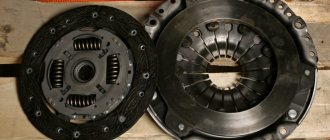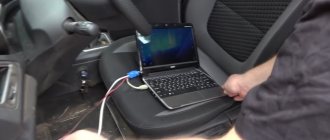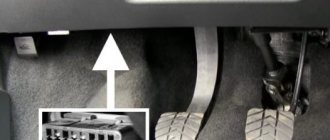With a working engine, an impeccable gearbox, and a new chassis, the car will not go anywhere without a clutch. On the Lada Vesta this is one of the most important components. The task of a mechanical clutch is to connect the internal combustion engine and manual transmission, transmitting torque from the engine to the chassis, and also to separate them when changing gears (if you leave the gearbox input shaft rotating through the internal combustion engine, the gears will inevitably be damaged).
The Lada Vesta clutch on a manual transmission (mechanical) consists of one disc, engagement is made mechanically (dry, permanently closed type), the drive is hydraulic. The latter means that the unit is driven by fluid pressure and is adjusted manually (by foot) by the driver. In addition, the fluid system acts as a pedal booster. After all, simply pressing with your foot is not enough to set in motion the structure, which engages with the shaft while rotating several thousand revolutions. Therefore, there is no need for hydraulics on an AMT. Read the article to the end and you will learn the intricacies of this knot! Find out the problems that often happen and the clutch drive fails: the release bearing or the basket as a whole is broken. It's time to change, or adjust enough, precise adjustment is important for good operation of the unit. Replacement at the dealer at 9 TO.
Clutch replacement on Lada Vesta cars under warranty
You can replace the clutch on a Lada Vesta under warranty. A similar procedure can be carried out when the car breaks down during the first 20,000 kilometers. If it is proven that neither the driver nor third-party manipulations are involved in the malfunction of the unit, the service center will carry out repairs free of charge. After the replacement, the brakes will also be bled. This is a mandatory process for a hydraulic drive, since after the intervention air cavities (plugs) are formed in the system. For a robotic gearbox, another manipulation is carried out - adaptation.
Under warranty: replacement of the clutch mechanism is also included in the list of TO9 works for the Lada Vesta. Even if the unit is working, it will have to be replaced. There is no need to worry about this; the life of the part has come to an end anyway, and it will not last long.
LADA Vesta: Adjusting the clutch pedal travel sensor
Some owners of LADA Vesta cars, while operating their cars, experience jerking, heaving and jerking when shifting into 1st, 2nd and 3rd gears. Sometimes, error number P0830 appears.
One of the reasons that can cause this behavior of the car is the incorrect operation of the clutch pedal travel sensor, whose incompletely thought-out design causes the above problems.
This sensor may differ depending on what modification of the car you own. In my case, it was a Renault 253250007R sensor with a rectangular rod and risks.
This element of the clutch system is located under the dashboard, next to the steering column and is attached to the top of the clutch pedal.
The problem with the machine jerking occurs when the rod plunges into the sensor housing. If you pull it out again to the required length and put the sensor in place, the problem will disappear and the car will begin to behave normally, but not for long, because any sudden return of the clutch pedal to its base state will cause the rod to shorten again.
The fact is that the white latches around the base of the rod cannot hold it when the clutch pedal is sharply returned and therefore, over and over again, the rod falls into the body and shortens, depriving the driver of comfortable movement and provoking jerks.
After all, the sensor transmits a signal about the position of the clutch pedal to the engine, and it, in turn, synchronizes its speed with the input shaft, which has a beneficial effect on the transmission.
Faced with this problem once again, I began to think about how to solve it once and for all. Having considered various options, I finally came to the conclusion that it was possible to install a spacer between the moving white part and the adjusting rod.
This way, I could fix the rod in the extended state at the required length and eliminate the possibility of it falling into the sensor.
As a spacer, I decided to use a conical cap from a pen, which I cut to 9.5 mm. I pulled the rod out of the sensor and put the cap on it so that the narrow side was directed towards the sensor body. Then, I installed the rod back into the sensor.
The spacer should not be thick, otherwise it will interfere with the movement of the rod and rest against the sensor body, and therefore the unit itself will not function correctly as a result.
In this case, the clutch pedal will also lose its travel and will not fully return to its basic state, and this in turn will affect the clutch release bearing, which will be constantly in a tense state and have increased wear.
Having finished modifying the clutch pedal travel sensor, install it in place
:
- Move the clutch pedal down with your hand;
- Install the sensor on the pedal assembly and turn it 90 degrees clockwise;
- Gently release the clutch pedal and connect the sensor connector.
Having installed everything in place, we check the operation of the clutch pedal - it should have a slight idle. If it is there, then the sensor modification has been completed correctly and you can begin operating the machine.
This modification to my car allowed me to get rid of jerking and the car began to move more smoothly, which is exactly what I wanted.
There are other variations of this modification. For example, some LADA Vesta car owners use a small tie and a toothpick instead of a cap, or wrap the stem with wire. I have not tested the effectiveness of such methods, so I cannot say anything about this.
https://club-vesta.ru/ustrojstvo/samostoyatelnaya-regulirovka-datchika-hoda-pedali-stsepleniya-lada-vesta-i-iks-rejhttps://xn--80aal0a.xn--80asehdb/do-my- self/repair/repair-lada-vesta/3568-regulirovka-datchika-sceplenija-na-lada-vesta-i-lada-xray.htmlhttps://vaz-russia.com/remont-lada-vesta/regulirovka-datchika- sczepleniya-na-lada-vesta.htmlhttps://remont-avtovaz.ru/regulirovka-i-prokachka-stsepleniya-na-lada-vesta/https://capfa.ru/1541-lada-vesta-regulirovka-datchika- hoda-pedali-sceplenija.html
Clutch adjustment on Lada Vesta cars
Since the knot is constantly engaged/disengaged, it needs fine adjustment. Adjustments are made on site during installation. The driven disk is centered, the basket, and the release bearing are also centered - they must fit exactly into the splines of the flywheel and the input shaft of the gearbox.
In the future, you can adjust the position of the clutch cable so that the pedal is softer/harder, so that it responds better to the command (during operation, the cable may stretch).
On a Lada with a robotic gearbox, the clutch is regulated by special programs. Adaptation can only be completed at an official dealer. However, the service life of the AMT clutch is significantly longer than that of a manual transmission.
Clutch faults
Vesta, depending on the type of transmission, may have a different drive. Accordingly, their problems may be different.
Problems with the hydraulic clutch
The brake fluid enters the working cylinder from the master cylinder through pipelines. The following malfunctions occur with these two main parts of the mechanism:
- excessive wear of rubber cuffs in cylinders;
- brake fluid leakage (lack of tightness at the pipe connections);
- damage to cylinders, pipelines, etc., which causes cracks to appear.
The hydraulic drive is highly reliable, but it can also fail if air gets into the system. The main sign of airing: incomplete disengagement of the clutch. Because of this, the gears will either be switched on with great difficulty or will be almost impossible to do. Typically, air enters the system when the level of brake fluid in the master cylinder reservoir is critically low, or due to loss of tightness. To troubleshoot problems, it is enough to bleed the system; a special fitting is provided for this.
There is no need to adjust the hydraulic clutch drive while the vehicle is in use.
The durability of the system depends on the driving style of the owner and operating conditions. A working clutch will not slip and fully transmit torque from the engine to the gearbox when the pedal is released. When the pedal is depressed, the transmission must be completely disconnected from the power plant.
You can check the performance of the hydraulic drive of the Lada Vesta manual transmission yourself, following a certain algorithm.
| What to do | What will happen |
| Turn off the engine and press the clutch pedal two or three times. | There should be no jamming, creaking, knocking or any other extraneous sounds in the drive mechanism. |
| Start the engine. | If at the same time a howling sound is heard from the manual transmission, which becomes more distinct when the pedal is depressed, it means that the release bearing is badly worn and needs to be replaced. |
| With the engine running, depress the clutch pedal and engage any speed. | At the same time, there should be no creaks, knocks, or crunches. Otherwise, extraneous sounds indicate incomplete disengagement of the clutch. This usually indicates airing of the system. If there is no air, it means there is a malfunction of the master or working cylinder, or a broken diaphragm spring. |
| With the engine running, turn on the speed and smoothly release the clutch pedal. | When the car starts to move, there should be no jerking or extraneous noise. Otherwise, the cause of failure may be damage to the discs, damper, or oil getting on the discs. |
| While driving, you need to press the accelerator pedal sharply. | If the revolutions have increased, but the car has barely accelerated, it means the clutch is slipping. It is easy to understand about slipping by the characteristic burning smell from the friction linings of the disc in the cabin. The problem is solved by replacing the disks. |
If after performing all these steps no problems are identified, the clutch can be considered working. The service life of the unit is reduced not only due to incomplete shutdown or slipping, but also when driving off-road, with a maximum load, when driving with a trailer or tow, or an aggressive driving style. And even in the case of such a seemingly harmless action as holding the clutch pedal depressed while the engine is running.
Malfunctions and methods for diagnosing them on AMT
The robotic gearbox of the Lada Vesta, as well as Kalinas, Grants, X-Rays, etc. cannot be called ideal. Many car enthusiasts may have problems when operating the robot. The most common malfunctions are jolts, howling, creaking, knocking, and jerking when changing gears.
The source of the noise can also be a worn release bearing. When replacing disks, it must also be replaced regardless of its condition. Clutch repair on an AMT is actually not easy, and this procedure is called “adaptation”. Although it is carried out by specialists using appropriate computer programs, you can diagnose faults yourself.
To do this, you should follow these steps.
- Turn on the ignition and make sure that the robotic gearbox is working. Depress the brake pedal and move the shift lever to any position. In this case, you need to ensure that all relevant icons appear on the dashboard screen. If the symbols are displayed, the selector lever is moved to the neutral position.
- Start the engine, but no sounds should be heard from the gearbox. A characteristic howl may indicate the need for urgent replacement of the release bearing. Similar sounds can also occur when transmission elements wear out.
- Press the brake pedal and use the lever to switch the selector to all positions. The gears should engage clearly, without crunching, knocking or howling. There may be several options here. A howling sound when the clutch engages indicates a worn release bearing. If the sounds disappear when the clutch is disengaged, these are worn out gearbox bearings. Jerks and jolts when shifting gears indicate incomplete disengagement of the clutch. The cause may also be a malfunction of the electromechanical clutch drive. In this case, you need to check the transmission control unit for errors. And for this you will need special software, which is available from the official dealer.
- Move the selector lever to the neutral position with the brake pedal depressed. If you release the pedal, the car should not move.
- Then you can carry out diagnostics on the go. Move the selector to the forward position, while gently pressing the accelerator pedal. The clutch should engage without problems. When moving with sudden acceleration and braking, you should make sure that the gears are downshifted and upshifted smoothly, without jerking or extraneous sounds.
- Turn on the manual control mode of the gearbox and carry out the actions described in the previous paragraph again. The transmission should operate normally, without any extraneous sounds.
- Stop the car and move the selector lever to the reverse position. When you press the accelerator pedal while releasing the brake pedal, the car should move in reverse. Jerks and jolts are unacceptable. Otherwise, this indicates damage to the clutch discs and friction disc damper. If the gears are engaged incorrectly or operate randomly, the transmission control unit should be diagnosed for errors.
If it is not possible to restore the functionality of the AMT, you should try to transfer the robot to manual control. This is especially true in the absence of spare parts. To do this, you need to remove the gear shift mechanism and the electromechanical clutch drive. You will also need to remove the drive cable. The fact that the clutch is faulty is indicated by the burning smell from the friction linings, as well as the lack of dynamics during acceleration. A variety of squeaks and other extraneous noises may indicate problems with the actuator.
The creaking of the Lada Vesta clutch actuator is considered the most common reason for contacting an official dealer.
Analogs
The manufacturers themselves recommend 826818 VALEO 2180 for Vesta. Owners note that when using the model, the pedal becomes noticeably softer and the car starts easily. The note applies to the original set; fakes are often found. The spare part costs four thousand eight hundred rubles.
The original part of the Lada Vesta is not suitable for the 21129 engine in terms of power; it is designed for lower speeds, for example, such as 2112. For 106 horsepower and above, TS-00001321 would not be a bad match. Price – five thousand six hundred rubles.
Required Tools
For the procedure you will need to prepare a certain kit.
- Set of wrenches from No. 10 to No. 24. You will also need socket heads.
- Screwdrivers – Phillips and flathead. Tools may be required in different sizes.
- Set of hex keys. Some bolts will have to be removed. Therefore, hexagons of normal quality will be required. When using a “disposable” tool, you can lick off the screw heads, which will result in their replacement.
- Rags – you will need a lot of rags, preferably clean ones.
- A torque wrench will be needed when reassembling the machine. It is strictly not recommended to tighten the bolts without it, by eye.
- A soft metal brush is needed to clean surfaces from dirt crusts.
- Clean containers for draining process fluids. If the car is still far from scheduled maintenance, it is not cost-effective to dump oils and other mixtures into scrap.
- A set of special plugs. If there are none, you can select a similar set of rubber plugs.
- Pliers with long and narrow pliers. You can use ordinary ones - it will be more convenient to carry out repairs with special ones.
Signs of clutch failure
The occurrence of malfunctions in the Vesta clutch mechanism is most often associated with improper operation (inexperience of the driver, aggressive driving style), an initial defect in the part, or breakdown of other components interacting with it. Of course, you will immediately notice problems with the clutch - the car will begin to behave differently:
- Gears are difficult to shift/do not work at all;
- Pedal too soft/hard;
- The car jerks;
- The device is activated in the upper position of the pedal.
There can be many reasons for this behavior of Vesta, and not all of them are related to the intermediate part between the internal combustion engine and the gearbox. Often the problem comes from the fluid system. There may be a malfunction of the brake master cylinder, clutch slave cylinder, damaged hoses, a simply low DOT4 level or an air lock. Such problems (especially problems with the cylinder of the unit) have exactly the same effect as the failure of the entire unit. The clutch consists of a housing cast together with the drive/pressure plate (basket) and the driven disc. The release bearing of the Lada Vesta acts on the petals of the basket, which, in turn, with the help of damper springs, press the inner disk away from the flywheel - the clutch opens. The bearing moves either under the influence of the hydraulic pedal drive (manually) - manual gearbox, or from the actuator (automatically) - manual gearbox. These parts can fail: more often - the release mechanism, less often - the basket body. Let's take a closer look at the most common “breakdowns”.
The design and principle of operation of the clutch
The pressure plate is located in a steel casing, which is bolted to the flywheel of the power plant. The friction disc is installed on the splines of the gearbox input shaft and is clamped by a diaphragm spring between the pressure disc and the flywheel. The guide bushing is a non-separable type unit, which includes the input shaft bearing and oil seal.
The bearing is moved by a ball bearing fork installed in the clutch housing. The fork is inserted into the grooves of the bearing coupling without fasteners. A drive (cable) is attached to the shoulder of this kind of shutdown lever, the second end of which is connected to the pedal in the cabin.
As the friction disc wears and operates, the clutch pedal travel is adjusted using an adjusting nut. It is located at the end of the cable.
The hydraulic clutch drive of the Lada Largus with the JR5 gearbox consists of the following components:
- the master cylinder, which is installed in the engine compartment,
- slave cylinder in the clutch housing,
- release bearing,
- pipeline with tubes and hoses,
- pedal.
The master cylinder is connected to a reservoir that contains the brake fluid. The reservoir also serves to connect to the brake cylinder. The slave cylinder is combined with the clutch release bearing, attached to the crankcase from the inside and exerts pressure on the bearing through a diaphragm spring. The hydraulic drive operates thanks to the presence of brake fluid. It does not need adjustment during its entire service life.
A flywheel is attached to the crankshaft of the Largus engine, which rotates during operation of the power unit. The flywheel contains a primary shaft, on the splines of which there is a clutch disc. Along these slots, the disc can move in both directions by several centimeters. The primary shaft is connected via a gear to the secondary shaft, which transmits torque to the axle shaft.
By pressing and releasing the clutch pedal, the driver adjusts the pressure of the disc from the engine flywheel. When the gear shift lever is moved to the neutral position, the secondary shaft gears do not mesh with the primary shaft gear. The same thing happens when the pedal is pressed: the driver engages the desired gear and, smoothly releasing the clutch, increases the speed. At this time, the gears gradually engage. The disc is pressed against the flywheel through the splines, thereby transmitting torque to the gearbox.
16-valve engines produce more power, so they use a clutch with a stiffer pressure spring and a friction disc damper. You can distinguish the discs by the slot of the spring petals and the damper springs, as they are marked with paint. The disk sizes used are the same.
You can install a disc from a 16-valve Largus engine onto an 8-valve one, but vice versa - you cannot.
The clutch does not disengage (drives)
Often, the Lada mechanism does not fully release due to the hydraulic clutch release. This could be due to poor drive adjustment, leaking fluid system, or cable wedge. Such breakdowns are easily eliminated. It is much more difficult when one of the elements of the main device breaks down.
If the mechanism does not completely disengage, it means that something is holding it: a deformed driven circle, the formation of dirt, rust in the spline joint, flywheel wear, as well as a change in the shape of the release fork, weakening of the pressure plate. In all cases, the disk will need to be replaced.
HYDRAULIC CLUTCH DEVICE LADA XRAY
The clutch engagement hydraulic drive consists of the clutch release master and slave cylinders connected by a pipeline. Through the pipeline, pressure is supplied to the working cylinder, which in turn transmits force to the central diaphragm spring of the clutch through the clutch release bearing. The clutch slave cylinder is assembled into a single unit with a release bearing (spare parts catalogs use both of these names to designate the part) and is installed in the clutch housing.
Brake fluid is used as the working fluid in the clutch hydraulic drive. It enters the clutch master cylinder through a hose from the brake master cylinder (MBC) reservoir. For this purpose, a pipe is made on the left side of the tank (No. 3 in the photo). The working fluid must be replaced regularly according to the maintenance plan.
Malfunctions of the master and slave cylinders include:
- wear of the clutch master cylinder cuffs;
- leakage of working fluid at the junction of tubes and fittings and from under the cuffs of the cylinder pistons.
Comment. If the working cylinder is leaking, brake fluid leaks from below from under the clutch housing. The presence of oil leaks in the same place is caused by wear of the gearbox input shaft oil seal. You should also check the clutch hydraulic hose and tube to make sure there are no cracks, cuts or other damage. We replace faulty parts.
Articles about Lada X Ray
Practical tuning of Lada Xray: protective covers for carpet
How Lada XRAY will feel in five years or 100 thousand kilometers
Lada Xray Cross: new details about the crossover
Lada Xray: do-it-yourself maintenance. Video.
Proper operation of the hydraulic clutch release drive is only possible if there is no air in the system, due to which the clutch may not disengage completely. As a result, changing gears will be difficult or impossible. Air can enter the system when the fluid level in the GTZ tank drops below the permissible limit, as a result of a violation of the tightness of the connections.
To remove air, it is enough to bleed the clutch release hydraulic drive. The bleeder fitting is made in the tip of the hydraulic drive tube.
Adjustment of the clutch release hydraulic drive during operation is not provided.
Jerks when starting off
If you notice that the movement is accompanied by twitching, this is a serious reason to seek help from specialists. The Lada Vesta can shake for various reasons (for example, ignition failures), but if it is the clutch mechanism that gives the effect, we are talking about scrap parts. Obsolescence will never be accompanied by jerks, but destruction, the breaking off of pieces of metal, manifests itself this way. The presence of freely moving debris can cause great damage to other Vesta nodes. It is recommended to carry out repairs immediately.
Noise when disengaging or engaging the clutch
The Vesta device is considered to be turned off when the pedal is lowered to the floor. It is always on when the driver's lever is in the free position - the internal combustion engine transmits torque to the transmission.
A noise similar to rustling, grinding, a slight hum, or howling appears when the unit is turned off. When turned on, it disappears. With almost one hundred percent probability we can say that the release bearing has worn out. Replacing it does not require removing the entire component. However, its untimely replacement leads to failure of the entire mechanism. A squelching, whistling sound when you press the pedal is associated with wear on the master or slave cylinders. There is pressure, the broken part does not hold it - the liquid breaks through further, making noise. The noise in the box disappears only when the clutch is disengaged.
The second type of sound is constant, disappears only when the gear is disengaged, and is located in the area of the gearbox. The nature of the “tinkling” of Lada Vesta is a weakened connection between the three main nodes.
Step-by-step instruction
Replacing the clutch on a Lada car will require a lot of time, effort, money and experience. Many car enthusiasts practice DIY repairs due to the high cost of professional services.
Prevention is complicated by the fact that the VAZ design has a pre-installed subframe that limits access to the units. In order to provide methodological assistance to owners of technical equipment, using the Lada Vesta car as an example, we will consider the process of independently replacing the clutch.
Results of the five-year plan
Five years is a serious time to draw conclusions about a car. The mileage on the Vesta is still a record for me: I have never driven so much in any car before. My sympathies for it are fickle, although the car has its advantages.
I'm not a fan of wiping your optics before every ride. Moreover, I don’t rub it dry. But such a humane approach did not protect the headlights from damage. The cap is full of micro-scratches and transmits light differently than in its youth. The quality of the low and high beams has dropped noticeably. A new headlight costs 12–16 thousand rubles. A piece! At this price, replacement is not an option - I'll try to polish it. I'll let you know about the results.
I'm not a fan of wiping your optics before every ride. Moreover, I don’t rub it dry. But such a humane approach did not protect the headlights from damage. The cap is full of micro-scratches and transmits light differently than in its youth. The quality of the low and high beams has dropped noticeably. A new headlight costs 12–16 thousand rubles. A piece! At this price, replacement is not an option - I'll try to polish it. I'll let you know about the results.
In terms of failure rate, the turn signal repeaters in the mirrors compete with the clutch. On the left side the third one has already “ended”. Judging by the simultaneous failure of all LEDs, the problem is in the wiring. I suspect due to daily folding.
In terms of failure rate, the turn signal repeaters in the mirrors compete with the clutch. On the left side the third one has already “ended”. Judging by the simultaneous failure of all LEDs, the problem is in the wiring. I suspect due to daily folding.
The chrome boomerangs have finally given up and look more and more shameful with every wash. The emblem on the radiator grille has also begun to bloom. AvtoVAZ is not doing well with pseudochrome! Maybe him?
The chrome boomerangs have finally given up and look more and more shameful with every wash. The emblem on the radiator grille has also begun to bloom. AvtoVAZ is not doing well with pseudochrome! Maybe him?
The protective cover on the engine is purely decorative. It does not protect against dirt and does not muffle the sound of a running engine. In addition, the protection has lost half of its fastenings and is shaking, trying to rub the surrounding pipes and wires. I took it off without regret and left it in the garage.
The protective cover on the engine is purely decorative. It does not protect against dirt and does not muffle the sound of a running engine. In addition, the protection has lost half of its fastenings and is shaking, trying to rub the surrounding pipes and wires. I took it off without regret and left it in the garage.
The battery and its mount look scary, but they perform their functions. I read online forums about different brands and understand that five years and 100,000 km for a battery is a very good resource by today’s standards.
The battery and its mount look scary, but they perform their functions. I read online forums about different brands and understand that five years and 100,000 km for a battery is a very good resource by today’s standards.
Everything in the rear chassis is normal. Haven't tried the drum brakes yet. On the front, let me remind you, we changed the pads twice and the discs once (with the last set of pads).
Everything in the rear chassis is normal. Haven't tried the drum brakes yet. On the front, let me remind you, we changed the pads twice and the discs once (with the last set of pads).
The front suspension has lost its former elasticity. However, the shock absorbers are dry and there are no obvious knocks. There was no indication for replacement, so I moved on.
The front suspension has lost its former elasticity. However, the shock absorbers are dry and there are no obvious knocks. There was no indication for replacement, so I moved on.
The release tarnished the reputation with a burnt-out corrugation, which was replaced under warranty. Otherwise, the system is still doing well. All suspension rubber bands are like new.
The release tarnished the reputation with a burnt-out corrugation, which was replaced under warranty. Otherwise, the system is still doing well. All suspension rubber bands are like new.
Chips, contrary to the long-standing VAZ tradition, do not turn red. But they survived several winters on the hood. For the quality of the metal - credit.
Chips, contrary to the long-standing VAZ tradition, do not turn red. But they survived several winters on the hood. For the quality of the metal - credit.
Lada VestaManufacturer - AVTOVAZ Year of manufacture - 2015 In operation "Behind the wheel" - since December 2015 Mileage at the time of report - 93,500 km |
Operating and maintenance costs (0–93,500 km)*
* Excluding transport tax, as well as costs for compulsory motor liability insurance and comprehensive insurance policies |
Lada Vesta after 93,500 km: detailed breakdown report











